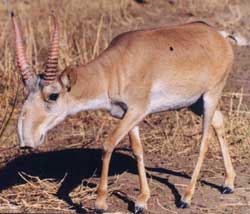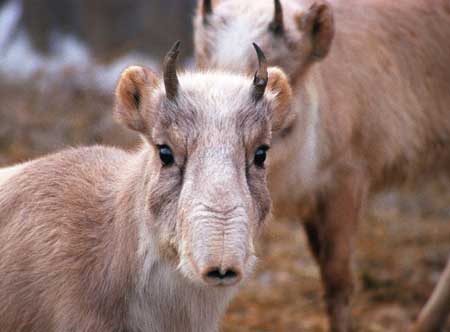The scientific name is Saiga tatarica, commonly found in Mongolia, Kazakhstan, and the Kalmykia region of Russia. The Saiga antelope is a herbivorous species, choosing to graze on over a hundred different types of grasses.
 |
|
Saiga Antelope – Male (Photo: redlist) |
Their bodies appear robust and strong, with a short tail. Their calls are reminiscent of cow moos. Males possess long, uniquely shaped horns that resemble wax and have small rings along their length.
Saiga antelopes weigh between 30-45 kg, with a shoulder height of approximately 0.6-0.8 m; their body length is around 1-1.5 m. The most notable feature is their large head with a highly mobile nose that resembles a small trunk. Many people believe that their unusual nostrils are adaptations to harsh climatic conditions, helping to warm and humidify the air before it enters the lungs.
The Saiga’s fur also exhibits remarkable adaptive features. In summer, their fur shortens, taking on a reddish-yellow color on the back and neck, while the belly is lighter. During the hottest parts of the day, they rest in place and do not move until sunset. However, in winter, they are active throughout the day; their fur grows thicker and longer in cold weather, changing to a dull gray on the back and neck, with a gray-brown color on the belly.
Females reach maturity at 7-8 months, while males take about 2 years to mature. The breeding season occurs from late November to late December, with a gestation period of 5 months, and females typically give birth to only 2 offspring per litter.
The Saiga antelope is a true “polygynous” species. During the breeding season, they gather in herds, with each herd consisting of 5-10 females and only one male. Males are very protective of their “harem.” During this time, mature males often engage in fierce battles, but they do not kill each other.
Many males do not graze at all during the breeding season and expend nearly all their remaining energy to fend off “rivals.” As a result, by the end of the breeding season, mature males become weak and often suffer a mortality rate of 80-90%.

(Photo: christine73.canalblog)
After the breeding season, Saiga antelopes regroup into large herds of 30-40 individuals, migrating together to avoid blizzards or droughts. Despite this large gathering, there is no leader among them.
Their fur, meat, and horns hold significant economic value. The horns, which are about 28-30 cm long, are the most valuable and are often ground into powder for use in antipyretic medicine.
Previously, this species of antelope was well-protected by the Soviet Union, but currently, their population is significantly declining due to overhunting.


















































